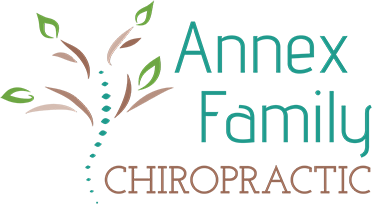Before we get into today’s content, a correction.
In last week’s email I added an image of my new adjusting tool, the Accustim. However, depending on what email provider you’re with, this may have landed in your inbox instead as a description vs an actual image. Oops! Sorry about that. Here is, in fact, what it looks like:

One of the takeaways of that email was how the repetitive woodpecker-like action of the Accustim helps “interrupt” and repeat the manual touch of your chiropractor so the neurologic feedback is more consistent throughout your adjustment. Translation = it can help produce ‘wow’ adjustments that last longer. It also facilitates positive, functional nerve responses, which are crucial to reducing pain and improving your health. If we haven’t used it together yet, and you’d like to find out more, let’s chat briefly at your next appointment.
While we’re on the subject of interrupting…
The “pattern interrupt” I want to tell you about today just might be THE MOST important ritual you can have for working from home right now. Allow me to explain. Many of my patients report they’re busier than ever with remote work and often feel a bit burnt out. And while there’s no doubt that working from home presents its own challenges, you can trace a lot of the symptoms of burnout back to how well you are balancing your work life against your home life.
The above is why it’s never been more crucial to create a ‘clocking out’ ritual that lets you wind down when the day is over (or contrarily start your day smoother than rolling out of bed to your desk…). Clocking out signals your brain it’s time to switch gears and focus on the other parts of your life that are also important. Psychologists call this technique ‘anchoring’. It helps you build a mental barrier between your work and personal life so you can better manage both your attention, and your energy. Clocking out can be as simple as announcing to family ‘I am done working for today’. Or, if you live alone, text it to a friend. It’s an easy way to set up the right intention.
But here are a few more tips from productivity experts on how to do this:
1. Physically take your work stuff and put it away in a drawer.
Putting pens, staplers, papers, and other work stuff away can really help “lock in” that sense of completeness. This is especially true if you don’t have a designated home office and you’re working at your dining room table or kitchen counter or something like that.
Ideally, you want these things out of sight. Seeing work objects laying around can trigger work emotions and cause a trailing of “work brain” into your home life.
2. Set your status to ‘away’ on workplace collaboration apps.
And, for best results, set your email autoresponder to let people know you’re not reading, and therefore won’t respond to, any email between off-hours.
It can feel a bit daunting to go that extra step, but it’s all part of setting healthy boundaries with co-workers and clients.
3. Make a list of priorities for the next day.
Writing down a short list of your most high-priority tasks for tomorrow not only boosts productivity but allows you to shut off thinking about what you ‘need’ to do next.
BONUS TIP:
Be sure to review these priorities again first thing in the morning before you get sucked into a vortex of emails and other work messages.
Anyway, hope you found this useful.
(I know I got some good reminders just putting this together!)
Bottom line: Nothing prevents burnout better than a well-functioning brain and nervous system.
Dr. Josh
===
“If you are interested in seeing a chiropractor, I wholeheartedly recommend Dr. Joshua. He is easy to talk with and has a gentle, hands-on approach. For those who don’t like being man-handled, you will appreciate this!” – Iris W.
===


